Odd Event Reviews... Tron
Andy Simpkins reviews the disc-throwing, light-cycle riding, digital world oddity that is the movie Tron
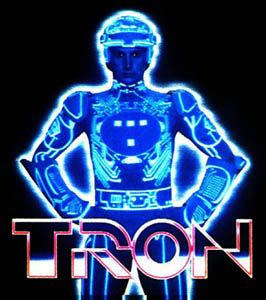
Greetings, Programs!
I thought it had to come out sooner or later. I have a secret passion. No, it doesn't involve sheep, raincoats and studded thongs or even Conservative MPs and a vat of industrial strength Swarfega...
Enough of you have had to hear me on our Staggering Stories podcasts waxing lyrical about Tron and its impending sequel: Tron Legacy to realise that it must be extra special in order to have me constantly burbling on about it.
I suppose it all happened one early summers evening back in 1983. I had earlier seen a magazine which had a review and a few pictures from the movie which had the intriguing title of 'Tron". Seeing pictures of renowned actors Jeff Bridges and David Warner wearing strange costumes in what could only be described as a phantasmagorical landscape grabbed my interest by the metaphorical short and curlies and had me on the phone to a good friend of mine saying that there is a film showing at the local cinema in East Grinstead that evening.
Later that very same evening, I was being gently but firmly guided back to his car, being in somewhat of a daze at what I had just witnessed....To say the film had an effect on me is somewhat akin to Saint Paul's conversion on the road to Tarsus.
Spoiler Alert+++Spoiler Alert+++Spoiler Alert
To the uninitiated, Tron is essentially about a man thrown into extraordinary circumstances and realising along the way what he is capable of. A young software engineer; Kevin Flynn, played by Jeff Bridges, once an aspiring computer games writer from computer corporation Encom, has had his most promising project, a video game called Space Paranoids, seized from him by another software engineer, not so young and not so bright, but very very sneaky, to coin his own words, called Edward Dillinger. Forced to eke out a modest living running a video game arcade while Dillinger has a meteoric rise through the ranks of Encom, Flynn seeks the help of Alan Bradley, another young programmer at Encom, and his girlfriend Laura Baines, who once had a romantic entanglement with Flynn, who along with her friend and boss, Walter Gibbs, is running a ground-breaking experiment in laser technology at Encom.
Breaking into the Encom building in the hope of gaining direct access to information which has been appropriated by Dillinger's creation, the super- intelligent Master Control Program, Flynn finds himself in the the laser bay, seated at a terminal trying to gain access to the information that will lead to Dillinger's downfall.
Flynn's efforts are in vain and in a scene of computer animation in its infancy but still awe-inspiring, Flynn is hit by a powerful laser beam and his body is broken down, digitised and shot into the electronic world of the Encom computer system....
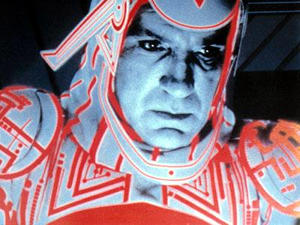
What follows is a visual feast as Flynn is immersed in a world where video games are life or death gladiatorial contests and computer programs are living, breathing people and the doppelgängers of their creators. Here he finds out that the Encom system is under the dictatorship of the Master Control Program and its lackey, Command Program Sark, who is the duplicate of Edward Dillinger. Very much a case of the master becoming the servant in this world. Computer programs who are still loyal to the Users are an underclass, either deleted, or de-rezzed as it is termed in the film, if they oppose the rule of the Master Control Program or are conscripted to play in the video games on the Game Grid.
One of the most gripping scenes of the film is the Light Cycle contest where Flynn, another program called Ram and Tron, the eponymous hero of the film, who shares an uncanny resemblance to Alan Bradley, are transported to a vast arena where, riding powerful motorcycle-like machines, that throw out solid walls of light in their wake, try to defeat three warriors of the MCP's elite force by walling and boxing them in or making them crash into their light-walls. Definitely a game where lightning-fast reflexes are called for as the opponents race at break-neck speed in order to defeat each other.
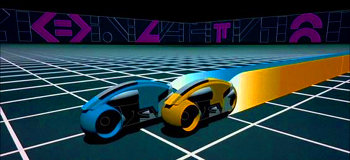
Utilising the destruction of one of their foes to effect an escape from the Light Cycle arena, Flynn, Ram and Tron run for their lives through the rectilinear landscape of the Game Grid on their Light Cycles. Taking shelter in a nearby cave, the three allies find a source of power that they refresh themselves with and discuss how they can destroy the MCP. Tron says that he will have to seek help from his User; Alan One, as Tron calls Alan Bradley and the only way to do that is to reach an Input/Output tower that they see in the distance so that he may contact his User
Rezzing up the light-cycles once again, Flynn, Ram and Tron make their way towards the I/O Tower but game tanks crewed by programs loyal to Sark and the MCP hit the three light-cycles with a salvo of shots and scattering them. Believing the three programs to be de-rezzed the tanks continue on their way.
Flynn and Ram were blown clear of the tanks but in doing so, Ram was severely wounded and it was down to Flynn to drag him clear of the rubble and drag him to safety. Tron, still in his light-cycle, scans the rubble for any sign of his friends but believing them to be dead, turns away in an agony of grief and rage and heads on towards the I/O Tower alone.
Meanwhile, Flynn and Ram find shelter in an abandoned shelter and lie down to rest. A short while later, they are woken from their slumber by a knocking and the sounds of machinery firing up. It is only when they look around themselves in amazement, they find out that the power that Flynn had taken of had caused the power systems of a Recogniser, a craft resembling an upturned 'U' and a dread symbol of the MCP's rule over the System, to warm up and start rezzing up. Flynn is overjoyed at this turn of events as he sees this as a way to help Tron and to find a way back to the human world. Ram, seeing what is happening, is awe-struck and tells Flynn that he should not be able to do that. Summoning Flynn over to where he is lying, Ram finds out the truth about his new-found friend; that he is not a conscript but a User, to a program a being of almost godlike powers that programs revere. A smile of revelation passes over Rams face as he slowly derezzes and is gone. Flynn is left alone and seemingly with no way out of the electronic world....
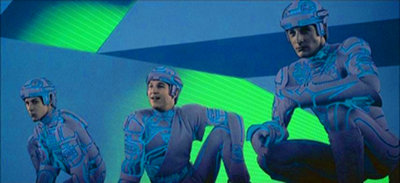
In the meantime, Tron has reached the area surrounding the I/O Tower. Before he can contact his User, he has to locate someone else who can help him. Making his way to an area of the complex he is in, he finds himself in an area where a game simulation model is being manufactured. In a vast hangar-like structure, a large and graceful ship is being constructed. Bearing a fleeting resemblance to a dragonfly, the solar sailer construct was capable of going anywhere in the System, riding beams of energy that criss-cross the entire electronic world.
Up in the control room a small army of female programs is working away at the controls that would bring the solar sailer to life. Among them is Yori, once a leading designer of game simulations but now reduced to a mindless drone. Grabbing her by the arm and leading her to a secluded area, Tron tries to rouse her from her torpor. Slowly, she recognises him and embraces him, reassured that her lover that had returned to her.
After explaining his situation to her, they make their exit from the simulation hangar and make their way toward the I/O Tower. Yori explained that she has an ally on the inside and that he would help them in Tron's efforts.
In the meantime, a Recogniser was weaving about and making its way towards the I/O Tower. After crash-landing it, Flynn takes stock and wonders what to do next. His plight is somewhat helped when a phalanx of programs led by Sark stride past. Seeing one program lagging behind, Flynn fells him with a blow and, with the intention of questioning him, finds that he is draining the fallen warrior of all his energy and the red fluorescent circuitry covering his body is leeching into Flynns blue body circuitry, essentially turning him into a warrior of the MCP. Scarcely believing his eyes, Flynn follows in the wake of Sark and the other warriors towards the I/O Tower.
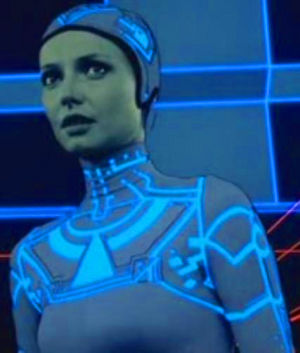
Standing at the entrance to the cathedral-like I/O Tower, Tron and Yori persuade the Tower Guardian; Dumont, who is the alter ego of Walter Gibbs, to hinder Sark's progress for as long as possible while Tron makes contact with Alan One. In the hallowed inner sanctum, Tron is able to make contact with Alan and he reprograms his identity disc with new coding to bring down the MCP and release the system from its bondage.
Making their way back to the solar sailer hangar, they are attacked by Sark's programs, one of whom is Flynn, who takes shelter away from the fighting.
The solar sailer and her crew make their escape away from the Game Domain and start their long journey towards their confrontation with the MCP. Flynn is discovered by Tron hanging from one of the rails and looking like he is about to fall to his doom. Hauling Flynn up onto the deck, Tron is taken aback as Flynn's body circuitry changes back to its normal blue hue. Again he realises that there be may be more to Flynn than meets the eye. This is confirmed when Flynn admits that he wrote the Light Cycle program. It is then he reveals that he is a User brought to the electronic world by the MCP. Tron and Yori are sceptical but Yori, being Laura Baines alter ego in the electronic world, has more than a passing fancy to this strange young man.
All too soon they are captured by Sark when Sark's carrier crashes into the solar sailer. Flynn and Yori and brought on board his carrier. Tron, believed to have died in the collision is actually clinging onto the hull of the carrier. Sark informs them that they and all surviving Tower Guardians are to be taken to the MCP for assimilation and Flynn and Yori are to be imprisoned on the carrier until it derezzes. The command module detaches itself from the carrier and makes its way to the stronghold of the MCP along with Tron who has managed to hold onto the hull.
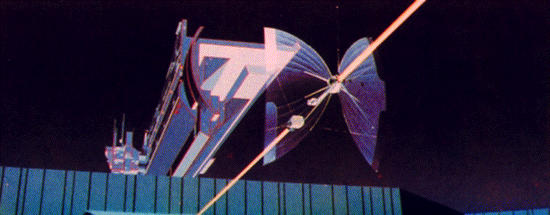
On the rapidly derezzing carrier, Flynn is horrified to see Yori slowly fading from existence. Grabbing hold of her, he passes some of his User energy into her and she comes back into existence. Unable to tell her the real reason for saving her, saying only that he needs her help.
Meanwhile, as the MCP is assimilating the Tower Guardians, it senses that Tron is on the mesa outside. He and Sark then have a disc battle which leaves Sark mortally wounded. Witnessing what is going on, Flynn steers the carrier over to the main energy beam emanating from the top of the MCP. Planning on jumping into the beam to distract the MCP long enough for Tron to do his work, he is momentarily stopped by Yori, who for reasons not entirely known to herself, embraces and kisses Flynn who then jumps into the beam.
Inside the domain of the MCP, Tron is throwing his reprogrammed disc at the MCP in order to destroy it but is horrified to see a giant Sark, his functions taken over by the MCP, now fearing for its very existence, enter and try to capture Tron. All of a sudden, both Sark and the MCP are taken by surprise as Flynn, having traveled down the beam, is sabotaging the functions of the MCP.
With the MCP, destroyed and Sark now dead, Tron, Yori, Dumont and the other Tower Guardians make their escape as the MCP explodes and releases its hoarded energy back into the system, a system now re-energised and revitalised.
Flynn, in the meantime, departs the electronic world and is re-assembled in the laser bay he had left, seemingly days ago but in reality, only a matter of hours. Next to him, a printer starts printing out the information, once jealously guarded by the MCP, that will exonerate Flynn and bring around Dillinger's demise.
The final shot is of Flynn, now the new CEO of Encom, greeting his new friends Alan and Laura. The scene then switched to a speeded up scene of Los Angeles, its streets and skies aglow with light and energy and none too different from the world that Flynn once visited....
To say this film had an effect on me is something of an understatement. To me, this whole film encapsulated the entire spirit of what was happening in the early 1980's. The world was experiencing both the advent of video games and the dawning of the domestic computer and digital age. The whole world was waking up to a new industrial and technological revolution and the movie Tron was ready to capitalise upon this.
Steven Lisberger, the producer, whose previous works included the Animalympics films, first got the idea when he bandied the idea of a short promotional film around. The film was that of a warrior of Herculean proportions throwing two discs of energy around in two parabolas before they crash into each other and release a large burst of energy and the four letters of some American radio stations that had agreed to use the film as advertising for their stations.
In that, the idea for a ground-breaking movie was hatched. Lisberger, along with his business partner, Donald Kushner, produced a short film featuring one of the US' première Frisbee throwers, wearing the electronic armour that would feature in Tron, going through his paces. After moving lock, stock and barrel over to the West Coast, they show the promotional material to various movie companies such as Warner Bros., MGM and Columbia, they went to the Disney Corporation
A that time at the turn of the '80's, Disney's output was becoming rather stale and they wanted to try things that were different and innovative. They looked at Lisberger and Kushner's handiwork and were very interested indeed.
The main challenge was the look of the new film. For this, they utilised the talents of three formidable designers; Syd Mead, who worked on the Blade Runner movie, Jean 'Moebius' Giraud, a prominent futurist and Peter Lloyd who, together, would bring the look of the electronic world to life in the form of such things as the armour that the programs would wear, the shape and look of the light-cycles, Game Tanks, the solar sailer, the Game Grid and many other such things
Even though Tron is cited as the worlds first computer-generated film, there is only about 20 minutes of CGI in the film. The rest is achieved through back-lit filming and colour separation techniques. The computer animation segments of the film were another matter entirely
At that time, the only faculties that had computers powerful enough to handle the millions of computations to make the images were either in the possession of universities of large companies or corporations. Three companies that were willing to take on the duties were Information International Incorporated, otherwise known as Triple I, MAGI and Digital Effects of California.
Triple I had previously made a short animation showcasing their talents. A man dressed as a circus ringmaster is standing on a vast chequerboard landscape with stars in the background. He is seen to be juggling a cone, a sphere and a cube. The camera zooms in on one of the shapes he is juggling and we are thrown into a montage of computer-generated images depicting shapes, ranges of motions and textures of various objects. Wire frame animation is then demonstrated before returning to the ringmaster juggling a plethora of shapes before doing a perfectly-executed back-flip and vanishing into thin air, leaving his top hat lying on the ground.
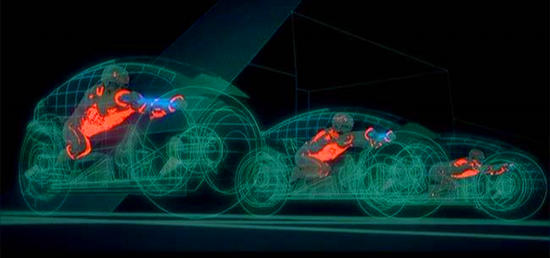
Triple-I were more than capable of carrying out the necessary work to bring such other-worldly machines like the light-cycles and the race in the arena. MAGI animated the solar sailer, the recognisers and Digital Imagery were responsible for the landscape of the electronic world and the rezzing up of Tron in the opening titles. All the effects were in place it was just down to one other vital component to complete everything
No film would be complete without actors and Steven Lisberger carried out numerous screen tests to find the various actors in order to complete the ensemble. Among those called in to read scripts were the renowned actor Kurt Russell, who proved worthy of appearing in the film but had to back out due to other commitments. A British actor of note who was screen-tested was Peter O'Toole. He was called in and accepted to play the part of Edward Dillinger/Sark but literally threw a hissy fit when he found out that the grand vistas and machinery of the electronic world were not real but would be reproduced via computer.
Kevin Flynn would be played by Jeff Bridges. Well known for his role in Thunderbolt and Lightfoot alongside Clint Eastwood, his stock in trade was portraying cocky but self-assured young men, a role that was well suited to him in portraying Flynn. Alan Bradley/Tron was played by Bruce Boxleitner; relatively unheard of at the time but would go onto greater things in such series as Bring 'Em Back Alive, Scarecrow and Mrs King and most importantly, the role of Captain John Sheridan in the smash hit sci-fi series Babylon 5.
After Peter O'Toole had thrown a strop and stormed off the set, the respected actor David Warner was called in to replace O'Toole in the role of Dillinger/Sark. During an interview, Steven Lisberger threw his hands up and apologised for commiting a sin that seems endemic in Hollywood nowadays; that of casting a British actor as a villain. However, David Warner had an impressive track record in Shakespeare on stage and on screen in various roles so he was more than happy to step up to the plate and bring the edge of malice and sadism deemed necessary to the role of Sark.
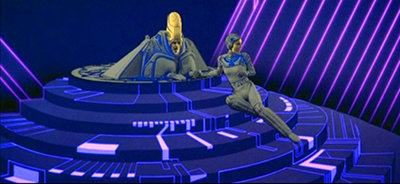
Cindy Morgan had previously appeared in the comedy film Caddyshack alongside Chevy Chase and Bill Murray and she ably provided the love interest in the film to Alan Bradley/Tron. One of the lesser known but amusing facts about the film was the figure-hugging leotards that the actors had to wear, alongside the helmets, vambrances and pauldrons they had to wear, the male actors each had to wear cricketers boxes to hide their masculinity and Cindy Morgan, in true does-my-bum-look-big-in-this mode, was horrified when she saw early film footage of herself and spent most of the following day exercising frantically in order to lose several pounds so she would look more svelte on-screen.
There were actors that filled lesser roles in the film but one that is worthy of note is Peter Jurasik. At he time he was just a jobbing actor called in to fill the role of Crom, a compound interest program at a savings and loan, otherwise known as building societies over here in the UK. He and his User, Mr Henderson, a full branch manager, had no idea of what was in store for them. Little did they know that in approximately thirteen years time, most of the alumni of Tron would be passing through the airlocks of Babylon 5.....Bruce Boxleitner I have already mentioned but David Warner would appear on Babylon 5 as a seeker after the Holy Grail and Peter Jurasik would have a recurring role as the Centauri ambassador; Londo Mollari. I may be wrong but I am sure that Steven Lisberger and J. Michael Straczynski had a covert agreement to have as many actors from Tron to appear in episodes of Babylon 5.
Dan Shor, a bluff but likeable New Yorker, filled the role of Ram, the actuarial program drafted into the games, with gusto. Resigned to his fate as a conscript on the Game Grid, reveled in his escape from his slavery and aided Tron and Flynn in their escape and efforts to bring down the MCP and its creature Sark.
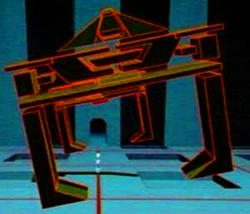
Barnard Hughes brought a touch of gravitas to the proceedings as the laser bay manager Walter Gibbs and as his alter-ego in the electronic world, the Tower Guardian, Dumont. Both, in their own way, were wanting to strip away the layers of mystery in their respective universes. Gibbs, wanting to push back the boundaries of science in his experiments with lasers and their manyfold uses and as Dumont, the Tower Guardian, a program who wants to find out more about the deities known to them as Users and to treat them and the programs communications with them with all the due reverence required.
Music also plays an important part in setting the mood of a scene and its ambience. For this, Wendy (formerly) Wayne Carlos was recruited to compose the more futuristic tones for the film whilst the London Philharmonic Orchestra was called in to provide the impressive film score necessary.
When Tron was released, it received mixed but mainly favourable reactions from the press and public alike. Made on a budget of $17m, it made a modest return of $33m. Despite its success, Steven Lisberger felt that the film could have been received more rapturously, seeing it was such a departure from what was being released, such as in the wake of Star Wars: The Empire Strikes Back. One cannot feel that until recently, he felt disappointed that a film that should have been a summer blockbuster only received a lukewarm welcome.
Despite the moderate reaction that Tron received on its release, over the years, the film has had a slow but inexorable move towards being a cult classic. Despite being a Disney film and therefore being sidelined as a 'kids' film, after almost thirty years, Steven Lisberger is surely vindicated as all of this was swept away in a truly dramatic style one day at the San Diego ComicCon 2008....
Tron was very much a product of its time and its sequel looks very much like doing the same, but on an immensely more spectacular style. Tron captured the dawning of the digital age and Tron:Legacy will depict the digital age in all its full glory. Watch this space on this fair website of ours for a review.
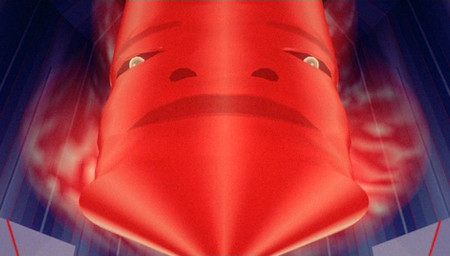
End of Line...






